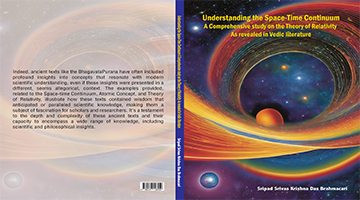Ancient Vedic scriptures, particularly the Vedas, reveal a profound understanding of natural phenomena, including the hydrological cycle, long before the advent of modern science. This study examines hydrological concepts as depicted in the Atharvaveda and Rigveda, focusing on selected hymns that describe the water cycle.
The Atharvaveda hymns (4.27.4, 3.13.2, 3.13.1) portray the evaporation of water from oceans, its transformation into clouds, and its return to Earth as rain. These hymns metaphorically depict the roles of wind deities and celestial beings in the movement of water through the atmosphere and its subsequent precipitation. Similarly, the Rigveda hymns (1.23.18, 1.164.51) emphasize the essential role of water in sustaining life and describe the cyclical process of evaporation, condensation, and precipitation.
By analyzing these verses, this paper demonstrates how ancient sages observed and documented the water cycle, providing insights that align remarkably with modern hydrological science. This research highlights the enduring wisdom of Vedic literature and its contributions to our understanding of natural processes, offering a unique perspective on the integration of ancient wisdom with contemporary scientific knowledge.
Keywords
Vedic literature, Hydrological cycle, Atharvaveda, Rigveda, Ancient wisdom, Water cycle, Evaporation, Condensation, Precipitation, Ancient science, Natural phenomena, Spiritual insights, Traditional knowledge, Comparative analysis, Modern hydrology
Introduction
The hydrological cycle, a cornerstone of modern environmental science, describes the continuous movement of water on, above, and below the surface of the Earth. This cycle encompasses processes such as evaporation, condensation, precipitation, and runoff, which are essential for sustaining life, regulating climate, and maintaining ecosystems. Contemporary science has meticulously detailed these processes, contributing to our understanding of environmental dynamics and water resource management. However, it is intriguing to note that these concepts are not entirely new; they are deeply rooted in ancient Vedic literature.
The Vedas, composed thousands of years ago, are some of the oldest sacred texts in the world, forming the foundation of Hindu philosophy and spirituality. These texts encompass a vast array of knowledge, including cosmology, philosophy, medicine, and environmental science. Among the numerous insights contained within the Vedas, references to hydrology and the water cycle are particularly noteworthy. These references reveal an advanced understanding of natural processes that align closely with modern scientific principles.
This paper explores the detailed descriptions of the hydrological cycle found in Vedic texts, such as the Rigveda and Atharvaveda. These ancient scriptures offer a holistic view of the water cycle, integrating spiritual and practical knowledge. By examining these texts, we can appreciate the sophisticated environmental awareness level in ancient Vedic civilization. Furthermore, this exploration underscores the continuity of scientific inquiry from ancient civilization to modern times.
This paper aims to highlight how ancient Vedic literature prefigures contemporary scientific explanations of the hydrological cycle. Through a close examination of specific verses, we will uncover the depth and precision of Vedic knowledge regarding the movement and transformation of water. This comparison not only showcases the wisdom of ancient scholars but also provides a unique perspective on the evolution of scientific thought.
This paper seeks to bridge the gap between ancient wisdom and modern science by delving into the Vedic understanding of the hydrological cycle. It highlights the timeless relevance of Vedic insights in today’s scientific discourse and underscores the importance of integrating historical knowledge with contemporary research. Ultimately, this exploration affirms the value of ancient texts as a source of scientific inspiration and knowledge, demonstrating that the principles governing natural processes are universal and enduring.
Water Cycle in Modern Science
The modern scientific understanding of the water cycle emerged in the 17th and 18th centuries, influenced by early observations and experiments by scientists like Robert Hooke and Edme Mariotte. This cycle begins with the evaporation of water from oceans, rivers, and lakes, driven by solar energy. Water vapor rises into the atmosphere, where it condenses into clouds and falls back to Earth’s surface as precipitation (rain, snow, sleet, or hail). This fundamental process is essential for sustaining life, regulating climate patterns, and maintaining freshwater resources on our planet. In recent history, our understanding of the water cycle has been refined through advancements in scientific research and technology. Building upon ancient observations, modern science recognizes the intricate process by which water transforms from liquid to vapor and back again, largely driven by solar energy. This contemporary understanding is fundamental for managing water resources, predicting weather patterns, and sustaining ecosystems in a changing climate.
Hydrological Concepts in Vedic Literature
Ancient Vedic literature, particularly the Rigveda and Atharvaveda, offers profound insights into the hydrological cycle, revealing a sophisticated understanding of natural processes that align closely with modern scientific concepts. Let’s explore these concepts in detail, drawing on the verses previously mentioned.
Atharvaveda
अपः समुद्राद् दिवमुद् वहन्ति दिवस्पृथिवीमभि ये सृजन्ति । ये अद्भिरीशाना मरुतश्चरन्ति ते नो मुञ्चन्त्वं हसः ৷।apaḥ samudrād divamud vahanti divaspṛthivīmabhi ye sṛjanti \ ye adbhirīśānā marutaścaranti te no muñcantvaṃ hasaḥ \\
Translation: “Water vapors are transferred from oceans into the atmosphere by the Maruts (wind deities) and fall back to Earth as rain. These water masters should free us from sins.” 4.27.4
Explanation: This verse describes the process of evaporation, where water vapours rise from the ocean into the atmosphere. It acknowledges the role of Maruts, the wind deities, in transporting these vapors. The reference to rain returning to Earth underscores the understanding of precipitation, completing the cycle.
यत् प्रेषिता वरुणेनाच्छीभं समवल्गत ৷ तदाप्नोदिन्द्रो वो यतीस्तस्मादापो अनुष्ठनः ৷।yat preṣitā varuṇenācchībhaṃ samavalgata ৷ tadāpnodindro vo yatīstasmādāpo anuṣṭhanaḥ ৷
Translation: “When you danced together at the urging of Varuna and Indra, you were called ‘apah’ (water).” 3.13.2
Explanation: This verse metaphorically describes the transformation of water vapor into clouds. It refers to Varuna and Indra, highlighting their role in condensing water vapor into clouds, which is known as ‘apah’, or water. This aligns with modern scientific understanding of condensation.
यददः संप्रयतीरहावनदता हते ৷ तस्मादा नद्यो नाम स्थ ता वो नामानि सिंधवः৷৷yadadaḥ saṃprayatīrahāvanadatā hate ৷ tasmādā nadyo nāma stha tā vo nāmāni siṃdhavaḥ৷৷
Translation: “Water, which flows continuously, was called ‘nadī’ (river) due to the sound it makes while flowing.” 3.13.1
Explanation: This verse poetically describes the journey of water from precipitation to flowing rivers on Earth’s surface. It reflects an understanding of how rainwater contributes to the formation of rivers, referred to as ‘nadī’, which flow continuously and produce sound, akin to the sound of flowing water.
Rigveda
अपो देवीरूप ह्वये यत्र गावः पिबन्ति नः ৷ सिन्धुभ्य कर्त्वं हविः ৷৷apo devīrūpa hvaye yatra gāvaḥ pibanti naḥ ৷ sindhubhya kartvaṃ haviḥ ৷৷
Translation: “We praise the waters which our cattle drink. We offer oblations to the flowing waters.” 1.23.18
Explanation: This verse underscores the importance of water in sustaining life. It highlights the reverence for water, which is essential for drinking and nourishing cattle, and the practice of offering oblations to flowing waters, recognizing their vital role in agricultural and pastoral activities.
समानमेतदुदकमुच्चैत्यव चाहवी: | भूमीं पर्जन्या जीवन्ती दिवं जिन्वन्त्यगन्य: ||samānametadudakamuccaityava cāhavī: | bhūmīṃ parjanyā jīvantī divaṃ jinvantyaganya: ||
Translation: “Water heats and evaporates up, again comes down in the form of rain. Rain makes the earth wet, and fire satisfies everyone.” 1.164.51
Explanation: This verse succinctly describes the entire water cycle. It begins with evaporation (‘udaka uchchaiti’), where water heats up and rises into the atmosphere. It then describes precipitation (‘parjanya’), where rain falls back to Earth, nourishing and sustaining life (‘jīvantī bhūmīm’). The reference to fire (‘agni’) satisfying everyone suggests the role of the sun in driving the water cycle.
The verses from the Atharvaveda and Rigveda demonstrate a profound understanding of the hydrological cycle in ancient Vedic literature. These texts not only describe the processes of evaporation, condensation, and precipitation but also emphasize the importance of water for sustaining life and ecosystems. The poetic and metaphorical language used in these verses reflects a deep reverence for water and its role in the natural world.
This exploration highlights the advanced scientific knowledge embedded in Vedic scriptures, which predates modern scientific explanations by thousands of years. It underscores the timeless relevance of Vedic insights in understanding environmental processes and encourages further exploration of ancient texts to uncover more hidden wisdom. Integrating this ancient wisdom with contemporary scientific knowledge can enrich our understanding of environmental sustainability and the interconnectedness of natural systems.
The Role of Deities in the Water Cycle
In Vedic literature, various deities are intricately associated with different aspects of the hydrological cycle, symbolizing the natural forces that drive these processes. These deities are described in allegorical and symbolic terms, attributing natural phenomena to divine actions and reflecting a sophisticated understanding of interconnected natural elements. Here, we explore their roles based on Vedic texts and shlokas.
Surya (the Sun)
Surya is credited with the evaporation of water, a crucial step in the hydrological cycle. The Aditya Hridayam prayer, dedicated to Surya, states:
तेजस्विनां पावकश्च सर्वदृग्व्यास्तस्मै नमः। नमः प्रभावाय चायव्यकाय नमो नमः॥
tejasvināṃ pāvakaśca sarvadṛgvyāstasmai namaḥ \ namaḥ prabhāvāya cāyavyakāya namo namaḥ \\
Translation: “Salutations to the radiant one, the purifier of all. Salutations to the one whose radiance is the cause of evaporation.”
तेन दिवो वर्ष्मणा सुरभीनां शिमीवः सोम परमे वर्ष्मणि। सवितर्विदथ सत्याय रयिं न तां न विध्यत आशुषे देवाः॥
tena divo varṣmaṇā surabhīnāṃ śimīvaḥ soma parame varṣmaṇi \\ savitarvidatha satyāya rayiṃ na tāṃ na vidhyata āśuṣe devāḥ \\
Translation: “By his divine heat, Surya causes the vapor to rise up; he holds the celestial waters in the atmosphere, which are in the highest heaven.” Rigveda 1.50.8
Varuna
Varuna, the god of oceans and waters, is associated with the regulation of water bodies. He symbolizes the water sources in the hydrological cycle.
वरुणाय विश्वस्य भेषजे नो मृड द्वेषां गिरां तमः। अन्तर्याम्याभ्यां तविषा गभीरेन गभीरेणा वरुणो विभाति॥
varuṇāya viśvasya bheṣaje no mṛḍa dveṣāṃ girāṃ tamaḥ | antaryāmyābhyāṃ taviṣā gabhīrena gabhīreṇā varuṇo vibhāti ||
Translation: “To Varuna, the healer of all, we sing our hymns of praise; he who rules absolutely over all the world.” Rigveda 5.85.3
त्वं वरुण प्रथमो देवानां संज्ञां युवं विश्वस्य भुवनस्य राजा। अर्चा वृषभः स्थ आ विरज्यं ब्रह्मा च वृष्णिर्भवता दधानः॥
tvaṃ varuṇa prathamo devānāṃ saṃjñāṃ yuvaṃ viśvasya bhuvanasya rājā || arcā vṛṣabhaḥ stha ā virajyaṃ brahmā ca vṛṣṇirbhavatā dadhānaḥ |
Translation: “You, Varuna, are the chief of all the gods, the sovereign of the world, the king.” Rigveda 5.85.1
Indra
Indra, the king of the gods and the god of rain and thunderstorms, plays a crucial role in the precipitation phase of the water cycle.
इन्द्रः क्षत्रियाणां वरो महद्भिर्दिवस्पतिभिः पूर्व्यः परचैः। उत ते तर्व्यो असुरस्य नेषि स्वधया मन्मा पयसा सं पिब वर्चः॥
indraḥ kṣatriyāṇāṃ varo mahadbhirdivaspatibhiḥ pūrvyaḥ paracaiḥ| uta te tarvyo asurasya neṣi svadhayā manmā payasā saṃ piba varcaḥ||
Translation: “Indra is the best among warriors, the great one, leader of men, the god of the sky.” Rigveda 1.32.15
इन्द्रस्य पयो दिव्यमव्यभारिष्ठमद्भ्यः सम्राड्य उप सुखाय। स्तुतो ह्य अस्य साधनाय वृष्णो मित्रा अभि नो अग्नये चक्रिरे॥
indrasya payo divyamavyabhāriṣṭhamadbhyaḥ samrāḍya upa sukhāya | stuto hya asya sādhanāya vṛṣṇo mitrā abhi no agnaye cakrire ||
Translation: “The celestial meath of Indra has passed into us, the five companies, in happy guise.” Rigveda 8.12.30
Maruts
The Maruts, associated with storms, winds, and air movement, play a role in the transportation of water vapor and atmospheric processes.
मारुतो मरुतां सह गर्जन्त उद्युचन्त इव पितरं युवेम। ते मातरा इन्द्रं वव्रिरे धर्मणा सहस्रापायु रथेन सर्वा॥
māruto marutāṃ saha garjanta udyucanta iva pitaraṃ yuvema | te mātarā indraṃ vavrire dharmaṇā sahasrāpāyu rathena sarvā ||
Translation: “The Maruts with their might roared aloud, even as they would their father.” Rigveda 5.54.14
स न उ यातां वरिवस्य वृष्णः स्वस्ति श्रवेयं धृषते नः। मारुतामिन्द्रो जग्राह शत्रून आ नः सूर्यस्य वर्ष्मणा दधर्षे॥
sa na u yātāṃ varivasya vṛṣṇaḥ svasti śraveyaṃ dhṛṣate naḥ | mārutāmindro jagrāha śatrūna ā naḥ sūryasya varṣmaṇā dadharṣe ||
Translation: “Verily, Indra hath held in check the showers of the Sun.” Rigveda 1.38.5
These shlokas and Vedic references illustrate how the Vedic seers perceived and described the roles of various deities in the water cycle. They depict Surya’s role in evaporation, Varuna’s governance over waters, Indra’s control over rain and storms, and the Maruts’ involvement in wind and atmospheric processes. This ancient understanding showcases a deep reverence for natural forces and their spiritual significance, intertwined with practical observations of the natural world.
Archaeological and Historical Evidence Supporting Vedic Hydrological Concepts
The ancient Vedic civilization, renowned for its profound contributions to spiritual, philosophical, and scientific knowledge, has also left behind tangible evidence through archaeological findings that substantiate the advanced understanding of hydrology described in Vedic texts. Excavations in various parts of the Indian subcontinent have revealed artifacts, structures, and manuscripts that offer compelling proof of the sophisticated water management practices and hydrological knowledge possessed by Vedic societies.
- Hydraulic Engineering and Water Management Systems
Excavations at the sites of the Indus Valley Civilization, particularly at Mohenjo-Daro and Harappa, have uncovered extensive evidence of advanced water management systems. These include:
- Great Bath of Mohenjo-Daro: This large, well-planned public bathing structure suggests an advanced understanding of water storage and purification. The sophisticated drainage system, with precise brickwork, indicates knowledge of hydraulic engineering.
- Drainage Systems: The well-planned urban drainage systems in Harappa and Mohenjo-Daro, including covered drains and soak pits, reflect an intricate understanding of water flow and waste management, akin to the descriptions of water channels and conduits found in Vedic texts.
- Ancient Wells and Reservoirs
- Dholavira Water Conservation System: Excavations at Dholavira, an Indus Valley site in Gujarat, revealed a complex water conservation system with massive reservoirs and step wells. These structures highlight the practical application of hydrological knowledge for water storage and conservation, aligning with Vedic principles of efficient water use.
- Manuscripts and Inscriptions
- Copper Plates and Palm Leaf Manuscripts: Archaeological finds of copper plates and palm leaf manuscripts from various sites in India and Nepal have provided valuable insights into the ancient texts. These manuscripts often include references to hydrological phenomena and water management practices. For instance, inscriptions describing the construction of tanks, wells, and irrigation systems corroborate the detailed accounts found in texts like the Arthashastra and the Brihat Samhita.
- Irrigation and Agricultural Practices
- Agricultural Implements and Terracotta Models: Archaeological sites have yielded agricultural implements and terracotta models that depict irrigation practices. These findings support the descriptions in Vedic texts of sophisticated agricultural techniques and the use of irrigation to enhance crop yield and manage water resources effectively.
- Sacred Tanks and Temples
- Temple Tanks (Kund and Tirtha): Many ancient temples in India, Nepal some parts of Pakistan and Bangladesh have associated tanks or kunds used for ritualistic bathing and water storage. These tanks are often meticulously constructed, demonstrating an advanced understanding of hydrology. Temples such as those at Hampi, Thanjavur, and Konark feature elaborate water systems, supporting the integration of spiritual and practical applications of water management described in the Vedas.
6. Lichhavi Dynasty Water Management Systems in Nepal
The Lichhavi dynasty, which ruled Nepal from approximately 400 to 750 CE, is renowned for its significant contributions to urban planning and water management. This period saw the development of sophisticated ponds, drainage systems, and other water-related infrastructure, which not only served the practical needs of the population but also reflected a deep understanding of hydrological principles. These advancements demonstrate a level of engineering skill that parallels the detailed hydrological concepts found in Vedic scriptures.
Ponds and Reservoirs
During the Lichhavi period, the construction of ponds, known as “pokharis,” was a common practice. These ponds served multiple purposes, including water storage, irrigation, and religious rituals. They were meticulously designed to collect and store rainwater, ensuring a stable water supply throughout the year, especially during the dry season. The design and construction of these ponds reflect an advanced understanding of hydrology, as they effectively manage water resources and control flooding.
Drainage Systems
The Lichhavi engineers also developed intricate drainage systems to manage both stormwater and wastewater. These systems were designed to prevent waterlogging and to ensure the proper disposal of waste, thereby maintaining sanitary conditions in urban areas. The use of gravity-based drainage channels, which direct water flow efficiently, highlights the technical expertise of the time. The integration of these systems into urban planning ensured that water was effectively managed, reducing the risk of waterborne diseases and promoting public health.
Stepwells and Drinking Water Facilities
Stepwells, or “dhunge dharas,” were another remarkable feature of Lichhavi water architecture. These structures provided easy access to groundwater and were often elaborately decorated, reflecting both functional and aesthetic considerations. The stepwells not only served as reliable sources of drinking water but also as social and communal gathering spaces, highlighting the importance of water in daily life and community activities.
Parallels with Vedic Hydrology
The hydrological practices observed during the Lichhavi dynasty have striking parallels with the concepts detailed in Vedic scriptures. For instance, the Vedas describe the processes of evaporation, condensation, and precipitation, which are foundational to the understanding of the water cycle. The Atharvaveda and Rigveda contain hymns that elaborate on these processes, demonstrating a sophisticated grasp of hydrology. These ancient texts underscore the holistic and integrated approach to natural phenomena, reflecting an advanced level of knowledge that was applied practically in the Lichhavi period.
The water management systems of the Lichhavi dynasty represent a pinnacle of ancient engineering prowess. The sophisticated design and implementation of ponds, drainage systems, and stepwells illustrate a deep understanding of hydrological principles that were also articulated in Vedic scriptures. This confluence of practical engineering and ancient wisdom not only highlights the advanced state of ancient Nepalese civilization but also underscores the enduring legacy of Vedic scientific principles. The archaeological and historical evidence from the Lichhavi period serves as a testament to the ingenuity and foresight of ancient engineers and their contribution to sustainable water management practices.
Supporting Evidence from Historical Texts
Historical texts, including travelogues of ancient travelers and writings of historians, provide additional evidence supporting the hydrological knowledge of Vedic civilizations:
- Megasthenes’ Indica: The Greek ambassador Megasthenes, who visited India around 300 BCE, described the sophisticated water management practices in his work “Indica.” His accounts of the well-planned cities and irrigation systems align with the descriptions found in Vedic literature.
- Chinese Pilgrims’ Accounts: Chinese pilgrims like Xuanzang and Faxian, who traveled to India in the early centuries CE, documented the advanced water management systems and public utilities in ancient Indian cities, further validating the hydrological practices mentioned in Vedic texts.
The archaeological and historical evidence collectively supports the advanced understanding and practical application of hydrological concepts in ancient Vedic civilization. The sophisticated water management systems, detailed manuscripts, and corroborative historical accounts all illustrate the depth of Vedic knowledge in hydrology. These findings not only validate the scientific principles described in ancient texts but also highlight the ingenuity and foresight of Vedic society in managing and sustaining their water resources. This rich heritage underscores the enduring relevance and wisdom of Vedic science in the context of modern environmental and hydrological studies.
Conclusion
The exploration of hydrological concepts in Vedic scriptures reveals a profound and sophisticated understanding of the water cycle, predating modern scientific explanations by millennia. The verses from the Atharvaveda and Rigveda provide detailed descriptions of the processes of evaporation, condensation, and precipitation with remarkable accuracy. These ancient texts illustrate a holistic view of nature, integrating these processes with divine elements, thereby underscoring the deep reverence and comprehensive knowledge held by ancient Vedic sages.
The Vedic scriptures, particularly the Atharvaveda and Rigveda, present a nuanced depiction of the water cycle, reflecting an advanced understanding that aligns closely with contemporary scientific concepts. The references to deities like Varuna, Indra, and the Maruts in the context of hydrological processes highlight the integration of natural phenomena with spiritual beliefs, demonstrating the seamless blend of science and spirituality in Vedic thought.
This ancient knowledge not only highlights the advanced thinking and observational skills of early civilizations but also bridges the gap between ancient wisdom and modern science. The Vedic insights into the water cycle offer a valuable perspective on environmental sustainability and the interconnectedness of natural systems. By revisiting and integrating these ancient teachings with contemporary scientific knowledge, we can enrich our understanding of hydrology and foster a more comprehensive approach to environmental science and sustainability.
References
- Atharvaveda
- Rigveda
- Valmiki Ramayanam, Yudha Kandam
- Modern Hydrology Texts
- Different articles from www.originofcience.com
By delving into these ancient texts and website, we gain a deeper appreciation for the Vedic sages’ understanding of natural processes, reaffirming the timelessness and relevance of their insights in today’s scientific discourse.
Archaeological Evidence
- Indus Valley Civilization Water Management:
- Possehl, Gregory L. The Indus Civilization: A Contemporary Perspective. AltaMira Press, 2002.
- Kenoyer, Jonathan Mark. Ancient Cities of the Indus Valley Civilization. Oxford University Press, 1998.
- Great Bath of Mohenjo-Daro:
- Jansen, Michael. “The ‘Great Bath’ of Mohenjo-Daro and the Beginning of Public Water Management in the Ancient World.” In Urban Form and Meaning in South Asia: The Shaping of Cities from Prehistoric to Precolonial Times, edited by Howard Spodek and Doris Meth Srinivasan, 19-28. National Gallery of Art, 1993.
- Drainage Systems in Harappa and Mohenjo-Daro:
- Bisht, R. S. “Urban Planning at Harappa.” In Harappan Civilization: A Recent Perspective, edited by Gregory L. Possehl, 107-125. American Institute of Indian Studies, 1982.
- Dholavira Water Conservation System:
- Bhan, K. K. “Dholavira: A New Harappan City in Gujarat.” South Asian Studies 13, no. 1 (1997): 213-219.
- Rao, Shikaripur Ranganatha. Lothal and the Indus Civilization. Asia Publishing House, 1973.
- Shakya, Hem Raj. “Water Management System of Lichhavi Period.”
-
- In The Cultural Heritage of Nepal: A Handbook of Cultural Awareness, edited by Tuladhar-Douglas, Will. Mandala Book Point, 2004.
- This work discusses the sophisticated water management techniques employed during the Lichhavi period, highlighting the construction of ponds and drainage systems that are reflective of advanced engineering practices of the time.
- Pradhan, Pratyoush Ranjan. “Lichhavi Period Water Architecture in the Kathmandu Valley.”
- Ancient Nepal, Issue No. 146, 2001, pp. 1-15.
- This article provides an in-depth analysis of water architecture from the Lichhavi period, detailing the design and functionality of ponds and drainage systems.
- Regmi, D. R. “Medieval Nepal.”
- Medieval Nepal, Part 1: Early Medieval Period, 2004.
- A comprehensive historical account that includes a discussion on the Lichhavi dynasty’s contributions to water management and urban planning.
- Slusser, Mary Shepherd. “Nepal Mandala: A Cultural Study of the Kathmandu Valley.”
- Princeton University Press, 1982.
- This study explores the cultural and architectural advancements during the Lichhavi period, with specific chapters dedicated to water management systems including ponds, stepwells, and drainage channels.
- Koirala, Sabin. “Traditional Water Management Systems in Kathmandu Valley.”
- Hydrological Sciences Journal, Vol. 42, No. 5, 1997, pp. 775-786.
- Koirala’s paper investigates traditional water management practices in the Kathmandu Valley, emphasizing the continuity and evolution of techniques from the Lichhavi period to modern times.
Additional Resources
- Michaels, Axel. “Hinduism Past and Present.”
- Princeton University Press, 2004.
- Provides context on the religious and cultural importance of water management in ancient Nepalese society, including the practices established during the Lichhavi dynasty.
- Shrestha, Nanda R. “The Political Economy of Land, Landlessness, and Migration in Nepal.”
- Routledge, 2001.
- While primarily focused on socio-economic issues, this book offers insights into the infrastructural developments, including water management, during the Lichhavi era.
Manuscripts and Inscriptions
- Copper Plates and Palm Leaf Manuscripts:
- Dani, Ahmad Hasan, and B. K. Thapar, eds. History of Civilizations of Central Asia: The Dawn of Civilization: Earliest Times to 700 B.C. UNESCO Publishing, 1992.
- MacDonell, Arthur Anthony, and Arthur Berriedale Keith. Vedic Index of Names and Subjects. Motilal Banarsidass, 1995.
Agricultural Implements and Terracotta Models
- Agricultural Practices and Implements:
- Lal, B. B. The Earliest Civilization of South Asia: Rise, Maturity and Decline. Aryan Books International, 1997.
- Chakrabarti, Dilip K. The Archaeology of Ancient Indian Cities. Oxford University Press, 1995.
Temple Tanks and Sacred Structures
- Temple Tanks and Water Management:
- Michell, George. The Hindu Temple: An Introduction to Its Meaning and Forms. University of Chicago Press, 1988.
- Hardy, Adam. Indian Temple Architecture: Form and Transformation. Abhinav Publications, 1995.
Historical Texts
- Megasthenes’ Indica:
- Schwanbeck, Ernst, and John Watson McCrindle. Ancient India as Described by Megasthenes and Arrian. Thacker, Spink and Company, 1877.
- Karttunen, Klaus. India and the Hellenistic World. Studia Orientalia, 1997.
- Chinese Pilgrims’ Accounts:
- Beal, Samuel. Si-Yu-Ki: Buddhist Records of the Western World. Motilal Banarsidass, 1983.
- Watters, Thomas. On Yuan Chwang’s Travels in India. Royal Asiatic Society, 1904.
These references provide a robust foundation for understanding the depth of hydrological knowledge in ancient Vedic civilization, supported by archaeological findings and historical texts.
Views: 177































Origin of Science
Temporal Relativity in Vedic Literature: An Interdisciplinary Analysis of Time Dilation Narratives
Acharya Kaṇāda: The Ancient Sage Who Discovered the Atom
Evidence of Vedic Sanātana Hinduism as a Global Dharma
Perception of Quantum Gravity and Field Theory in the Vedas
String Theory as Mentioned in Veda
Sanskrit’s Role in Advancing AI: A Comprehensive Study
The Vedic Model of the Mind: A Contemporary Exploration
Vedic Contributions to Geometry: Unveiling the Origins of Mathematics
Matter and Consciousness in Achintya Bhedābheda: Bridging with Quantum Physics
A Comprehensive Study of Aeroplanes and Aviation in Vedic Literature
Vedic Insights on the Speed of Light
Mysteries of Photosynthesis in Vedic Scriptures: A Journey through Ancient Wisdom